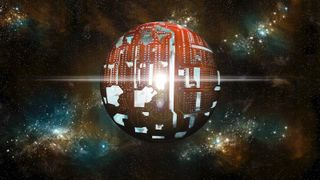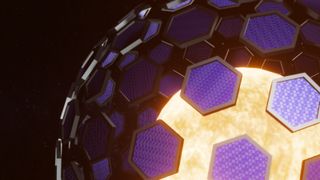
Scientists have identified at least seven stars that could be surrounded by Dyson spheres.
(Image credit: Marc Ward/Stocktrek Images/Getty)
At least seven stars in the Milky Way show signs of potentially harboring a hypothetical, super-advanced form of alien technology known as a Dyson sphere, scientists claim. While the researchers can not be totally sure that these stars host intelligent civilizations, they will undoubtedly pique the interest of scientists searching for extraterrestrial life in the cosmos.
Theoretical physicist Freeman Dyson first proposed Dyson spheres in 1960. The general idea is that technologically superior alien civilizations might build gigantic structures surrounding their home stars, or around black holes, in order to harness the objects’ gargantuan energy output and further advance their civilizations. The most extreme version of these megastructures would be an enormous sphere that encapsulates an entire star, and lesser versions could include ring stations and swarms of gigantic mirrors.
While scientists argue over the likelihood of a civilization ever becoming advanced enough to construct such behemothic structures, researchers think that if Dysons spheres do exist, we should probably be able to spot them. This is because, if a Dyson sphere did surround an alien star, the heat from that star would cause the sphere to heat up and emit large amounts of infrared radiation.
As a result, Dyson sphere-hunters look for spikes in these wavelengths, known as infrared excess emissions (IEEs), among the spectra of distant stars. They are one of the key technosignatures that alien-hunting astronomers look for — alongside weird radio signals, atmospheric greenhouse gases and artificial light.
Related: What’s the best evidence we’ve found for alien life?

Dyson sphere variations, such as a Dyson swarm, could also emit IEEs. (Image credit: Getty Images)
In a new study, published May 6 in the journal Monthly Notices of the Royal Astronomical Society, researchers used a computer program to look for IEEs among more than 5 million stars in our galaxy surveyed by a range of different observatories, including the European Space Agency’s Gaia spacecraft, NASA’s Wide-field Infrared Survey Explorer (WISE) and Two Micron All-Sky Survey (2MASS). Remarkably, this program identified seven strong candidates for sphere-bound stars.
All seven stars highlighted by the study are M-dwarf stars — a class of main sequence stars that are smaller and dimmer than the sun. They are all located within 1,000 light-years of Earth, researchers wrote in the study.
Get the world’s most fascinating discoveries delivered straight to your inbox.
This is not the only recent study to identify potential IEEs. A near-identical study, which was uploaded March 27 to the preprint server arXiv, also analyzed around 5 million stars surveyed by Gaia, WISE and 2MASS and found 53 potential IEE candidates. However, it is unclear if both studies analyzed the same data set. The March paper has not been peer-reviewed.
In both studies, researchers accounted for factors that could produce false-positive IEE results, such as nebulas surrounding stars. However, it is impossible to fully rule out other explanations, such as extreme debris disks — large clouds of rock and dust left behind by collisions between exoplanets that get similarly superheated by their home stars, researchers wrote.
Researchers say the next step will be to carry out follow-up observations on the newly identified candidate stars using more powerful instruments, such as the James Webb Space Telescope, to take more accurate readings and search for other signs of intelligent extraterrestrial life in these systems.
Harry is a U.K.-based senior staff writer at Live Science. He studied marine biology at the University of Exeter before training to become a journalist. He covers a wide range of topics including space exploration, planetary science, space weather, climate change, animal behavior, evolution and paleontology. His feature on the upcoming solar maximum was shortlisted in the “top scoop” category at the National Council for the Training of Journalists (NCTJ) Awards for Excellence in 2023.
>>> Read full article>>>
Copyright for syndicated content belongs to the linked Source : Live Science – https://www.livescience.com/space/astronomy/alien-dyson-sphere-megastructures-could-surround-at-least-7-stars-in-our-galaxy-new-studies-suggest




















![Forest ecology cannot be reduced to arithmetic, says M.I. Varghese [Interview] – Mongabay-India](https://earth-news.info/wp-content/uploads/2025/12/328946-forest-ecology-cannot-be-reduced-to-arithmetic-says-mi-varghese-interview-mongabay-india-350x250.jpg)










![Forest ecology cannot be reduced to arithmetic, says M.I. Varghese [Interview] – Mongabay-India](https://earth-news.info/wp-content/uploads/2025/12/328946-forest-ecology-cannot-be-reduced-to-arithmetic-says-mi-varghese-interview-mongabay-india-120x86.jpg)